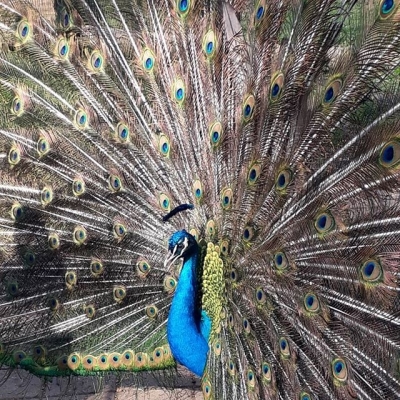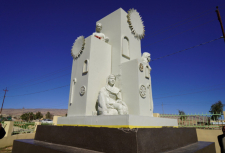Notes on the yazidi religious syncretism

Victoria Arakelova
Caucasian Centre for Iranian Studies
Yerevan Despite its unique and the extremely original character, Yazidism reveals a number of striking parallels with other syncretic religions, in particular, with the heterodox Shi‘a sects. A part of these parallels are certainly the common elements, derived from the Islamic Mysticism and, probably, Gnostic teachings (for some Extreme Shi‘a doctrines, like the Isma’ili, the latter is quite certain: they have been formed under a direct influence of the Christian Gnosticism). As to the proper Extreme Shi‘a elements in the Yazidi religion, they can be the result of a later influence. The Extreme Shi‘a sects, generally known as Ghul, are distinguished, at least formally, by their specific attitude towards ‘Ali (i. e., ‘Ali ibn Abi Talib, the Fourth Caliph, cousin and son-in-law of the Prophet), glorifying him as an object of worship, as of supreme worth. However, in some of them, ‘Ali is rather a fairly marginal figure, with the obvious traits of an epical hero. Among these sects, the largest number of parallels with Yazidism is found with the Ahl-i Haqq (People of the Truth) and in the religion of the Zazas. One of the main analogies is, first and foremost, the religious institution of “Brother and Sister of the Next World”, as well as a number of common characters (‘Ali, Fatima, etc.) deified by the heterodox Sh‘ites and marked in Yazidism.
With regard to the Ahl-i Haqq in Iran, one of the sect’s autonymics is Y"res"n (the Iraqi Ahl-i Haqq are named Kakai"), while the Yazidi self-denomination is ezdikhana, “the abode of the Yazidis”. The term Y"res"n is perhaps going back to y"rest"n, “the abode of those in love (with God)”, with the suffix -st"n indicating “place”, and y"r “beloved”. The formation of these two terms, "n" and Y"res(t)"n, in fact, is based upon one and the same principal concept—the idea of community as the abode (home) of co-religionists (the faithful).
Like the Yazidis, the Ahl-i Haqq must have spiritual masters—with the latter these are pirs and dalils from among the hereditary caste of religious leaders or seyyeds, thus shaping the x"nd"n, or families, comprising the spiritual tutors and their disciples from among the caste of laymen or mur3ds. The similar hierarchy, social structure of society and the institution of spiritual tutorship is also observable among the other heterodox Shi‘ites, the Alevi Zazas. Parallels are also traced in the cosmogony of the Ahl-i Haqq and of the Yazidis: The One God, the primeval Creator initially created a pearl, which contained all elements of the Universe. In the religious doctrine of the Ahl-i Haqq there are seven images— hafttan, being effectively analogous to the seven avatars of Malak-Tawus in the Yazidi religion.
In both cases, they are the seven great angels; particularly visible is the position of the four angels governing the four elements: fire, water, earth, and wind. The concept of the seven angels penetrated to Yezidism from the Biblical-Muslim tradition; in a very similar form and functional meaning it occurs in the religious beliefs of the Extreme Shi‘a sects in general. In Gnostic tradition, too, there is an idea of the Seven Creator Angels, though associated with the Seven Days of Creation, the latter being a matter of interpretation only. Of special interest is the problem of reincarnation. In the contemporary Yazidism the concept of tanasux (reincarnation, re-embodiment) is somewhat vague—it is existent, though not dominating.
This idea, of course, is antagonistic itself to the tradition of paradise and hell, as the latter rules out the need for reincarnation. However, this type of syncretism converging the inconsistencies is a phenomenon rather typical of Yazidism. The idea of reincarnation, surprisingly coexistent with the tradition of paradise and hell, excluding the need for reincarnation, is widely spread in the esoteric trends of Islam, in particular, in a number of Extreme Shi‘a sects. In the concept of Ahl-i Haqq the human beings have to pass through a thousand and one reincarnations (depending upon the deeds in previous incarnations). Another heterodox Shi‘a sect, the Nusayris, recognize the reincarnation of men only. Today, the nearly forgotten character in the Yazidi tradition, Shekiras" s (mentioned only by J. Furlani)—«Sheikh of the Robe», was perhaps responsible for the process of death, and possibly, for reincarnation, replacement of bodies as change of clothes. A similar parallel is also attested in the Gnostic tradition.
Tags: #yazidisinfo #yazidi #ezidi
Notes on the yazidi religious syncretism

Victoria Arakelova
Caucasian Centre for Iranian Studies
Yerevan Despite its unique and the extremely original character, Yazidism reveals a number of striking parallels with other syncretic religions, in particular, with the heterodox Shi‘a sects. A part of these parallels are certainly the common elements, derived from the Islamic Mysticism and, probably, Gnostic teachings (for some Extreme Shi‘a doctrines, like the Isma’ili, the latter is quite certain: they have been formed under a direct influence of the Christian Gnosticism). As to the proper Extreme Shi‘a elements in the Yazidi religion, they can be the result of a later influence. The Extreme Shi‘a sects, generally known as Ghul, are distinguished, at least formally, by their specific attitude towards ‘Ali (i. e., ‘Ali ibn Abi Talib, the Fourth Caliph, cousin and son-in-law of the Prophet), glorifying him as an object of worship, as of supreme worth. However, in some of them, ‘Ali is rather a fairly marginal figure, with the obvious traits of an epical hero. Among these sects, the largest number of parallels with Yazidism is found with the Ahl-i Haqq (People of the Truth) and in the religion of the Zazas. One of the main analogies is, first and foremost, the religious institution of “Brother and Sister of the Next World”, as well as a number of common characters (‘Ali, Fatima, etc.) deified by the heterodox Sh‘ites and marked in Yazidism.
With regard to the Ahl-i Haqq in Iran, one of the sect’s autonymics is Y"res"n (the Iraqi Ahl-i Haqq are named Kakai"), while the Yazidi self-denomination is ezdikhana, “the abode of the Yazidis”. The term Y"res"n is perhaps going back to y"rest"n, “the abode of those in love (with God)”, with the suffix -st"n indicating “place”, and y"r “beloved”. The formation of these two terms, "n" and Y"res(t)"n, in fact, is based upon one and the same principal concept—the idea of community as the abode (home) of co-religionists (the faithful).
Like the Yazidis, the Ahl-i Haqq must have spiritual masters—with the latter these are pirs and dalils from among the hereditary caste of religious leaders or seyyeds, thus shaping the x"nd"n, or families, comprising the spiritual tutors and their disciples from among the caste of laymen or mur3ds. The similar hierarchy, social structure of society and the institution of spiritual tutorship is also observable among the other heterodox Shi‘ites, the Alevi Zazas. Parallels are also traced in the cosmogony of the Ahl-i Haqq and of the Yazidis: The One God, the primeval Creator initially created a pearl, which contained all elements of the Universe. In the religious doctrine of the Ahl-i Haqq there are seven images— hafttan, being effectively analogous to the seven avatars of Malak-Tawus in the Yazidi religion.
In both cases, they are the seven great angels; particularly visible is the position of the four angels governing the four elements: fire, water, earth, and wind. The concept of the seven angels penetrated to Yezidism from the Biblical-Muslim tradition; in a very similar form and functional meaning it occurs in the religious beliefs of the Extreme Shi‘a sects in general. In Gnostic tradition, too, there is an idea of the Seven Creator Angels, though associated with the Seven Days of Creation, the latter being a matter of interpretation only. Of special interest is the problem of reincarnation. In the contemporary Yazidism the concept of tanasux (reincarnation, re-embodiment) is somewhat vague—it is existent, though not dominating.
This idea, of course, is antagonistic itself to the tradition of paradise and hell, as the latter rules out the need for reincarnation. However, this type of syncretism converging the inconsistencies is a phenomenon rather typical of Yazidism. The idea of reincarnation, surprisingly coexistent with the tradition of paradise and hell, excluding the need for reincarnation, is widely spread in the esoteric trends of Islam, in particular, in a number of Extreme Shi‘a sects. In the concept of Ahl-i Haqq the human beings have to pass through a thousand and one reincarnations (depending upon the deeds in previous incarnations). Another heterodox Shi‘a sect, the Nusayris, recognize the reincarnation of men only. Today, the nearly forgotten character in the Yazidi tradition, Shekiras" s (mentioned only by J. Furlani)—«Sheikh of the Robe», was perhaps responsible for the process of death, and possibly, for reincarnation, replacement of bodies as change of clothes. A similar parallel is also attested in the Gnostic tradition.
Tags: #yazidisinfo #yazidi #ezidi


























